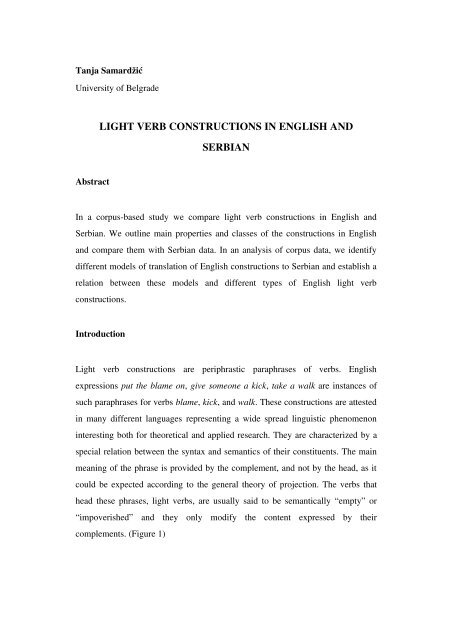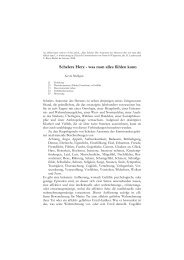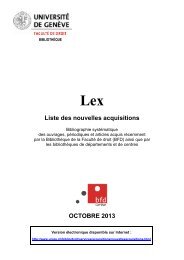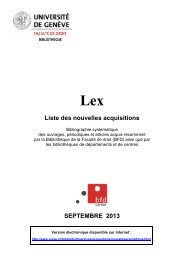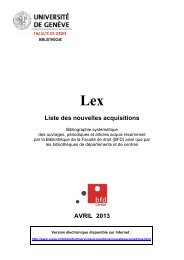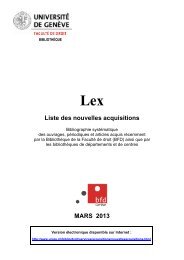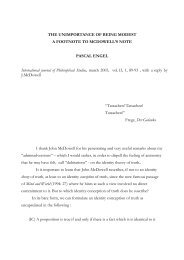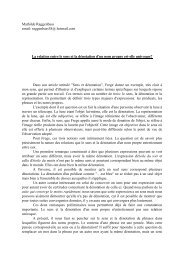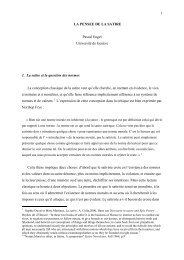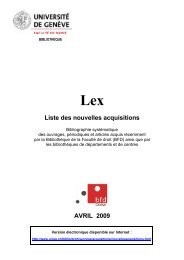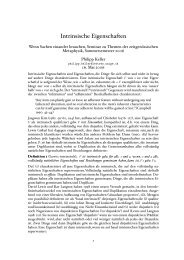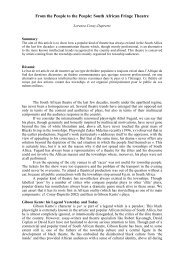Tanja Samardžić
Tanja Samardžić
Tanja Samardžić
Create successful ePaper yourself
Turn your PDF publications into a flip-book with our unique Google optimized e-Paper software.
<strong>Tanja</strong> <strong>Samardžić</strong><br />
University of Belgrade<br />
LIGHT VERB CONSTRUCTIONS IN ENGLISH AND<br />
SERBIAN<br />
Abstract<br />
In a corpusbased study we compare light verb constructions in English and<br />
Serbian. We outline main properties and classes of the constructions in English<br />
and compare them with Serbian data. In an analysis of corpus data, we identify<br />
different models of translation of English constructions to Serbian and establish a<br />
relation between these models and different types of English light verb<br />
constructions.<br />
Introduction<br />
Light verb constructions are periphrastic paraphrases of verbs. English<br />
expressions put the blame on, give someone a kick, take a walk are instances of<br />
such paraphrases for verbs blame, kick, and walk. These constructions are attested<br />
in many different languages representing a wide spread linguistic phenomenon<br />
interesting both for theoretical and applied research. They are characterized by a<br />
special relation between the syntax and semantics of their constituents. The main<br />
meaning of the phrase is provided by the complement, and not by the head, as it<br />
could be expected according to the general theory of projection. The verbs that<br />
head these phrases, light verbs, are usually said to be semantically “empty” or<br />
“impoverished” and they only modify the content expressed by their<br />
complements. (Figure 1)
Figure 1: The structure of a light verb construction compared with a typical verb<br />
phrase. The dashed arrows denote the direction of projection.<br />
The special relation between their structure and meaning makes these<br />
phrases semantically noncompositional or opaque to a certain degree. The<br />
meaning of the phrase cannot be simply calculated from the meaning of its<br />
constituents. Moreover, the use of these phrases is partially conventionalized.<br />
They show some properties of expressions or collocations, but on the other hand,<br />
the pattern of their formations is relatively productive and some grammatical<br />
regularities can be identified. This is why light verb constructions require special<br />
treatment in translation, second language teaching and learning, as well as in<br />
lexicography.<br />
In this study we compare light verb constructions in English and Serbian.<br />
We take a corpusbased approach examining a sample of English constructions<br />
against their translation equivalents in Serbian. The aim of the research is to<br />
establish models of grammatical correspondence as well as to examine factors that<br />
are relevant for modelling.<br />
We describe and compare properties of the constructions in English and<br />
Serbian in the next section underlining the structural differences between the<br />
languages. Then we present a corpusbased analysis of English constructions<br />
formed with the verbs have, make, and take and their translation equivalents in<br />
Serbian identifying models of correspondence. Finally, we discuss the models and<br />
the factors that are taken into consideration in comparing these constructions.
Comparison of light verb constructions<br />
In this section we compare the two constituents of light verb constructions in<br />
English and Serbian – the light verb and its complement.<br />
Light verbs<br />
The light verb that head light verb constructions is a special verb that has<br />
no or little semantic content. In fact, both in English and Serbian these verbs are<br />
special usages of otherwise “heavy” or semantically fully specified verbs (1a and<br />
2a vs. 1b and 2b):<br />
(1) a) Mary had a laugh. ( ≈ Mary laughed.)<br />
b) Mary had a yacht.<br />
(2) a) Marija je imala osećaj da… ( ≈ Marija je osećala da…)<br />
Mary had feeling+ACC that Mary felt that<br />
‘Mary had a feeling that…’ ( ≈ ‘Mary felt that…’)<br />
b) Marija je imala jahtu.<br />
Mary had<br />
‘Mary had a yacht.’<br />
yacht+ACC<br />
The relation between these two usages of verbs in English is a subject of<br />
discussion. Kearns (2002) makes a distinction between true light verbs and vague<br />
action verbs. Only the constructions with true light verbs (3a) are considered to be<br />
special constructions. They have a fixed syntactic structure: their complement<br />
must be indefinite, they cannot be passivized, and they do not undergo WH<br />
movement. Their meaning is specific too – they denote a brief, single action. 1<br />
According to this approach, true light verbs have no semantic content and hence<br />
no semantic relation with their heavy counterparts. The constructions with vague<br />
1<br />
Wierzbicka (1982: 759) gives a similar, more elaborated semantic description of the<br />
constructions with the verb have: “The have a V construction is agentive, experienceroriented,<br />
antidurative, atelic, and reiterative”.
action verbs (3b) are not characterized by any of these properties. Although they<br />
can be paraphrases of verbs, they are considered as regular instances of verb<br />
phrases. The relation between vague action verbs and fully specified verbs is not<br />
discussed.<br />
(3) a) John gave the bottle a shake.<br />
b) John made an inspection.<br />
The difference between true light verbs and vague action verbs is relevant<br />
for Serbian too. (3a) cannot be translated with a phrase to Serbian, it is translated<br />
with a single prefixed verb (4a). The prefix is the element of structure that<br />
changes verb’s aspect in Serbian, which makes its role parallel to that of the light<br />
verb in English. On the other hand, (3b) can be translated with a phrase but the<br />
verb is not a lexical counterpart of the English verb and it bears a prefix too (4b).<br />
Only the fully specified use of the verb can be translated with a lexical counterpart<br />
(1b, 2b). 2<br />
(4) a) Jovan je promućkao flašu.<br />
John shaked+PREFIX bottle+ACC<br />
b) Jovan je izvršio inspekciju.<br />
John did+PREFIX inspection+ACC.<br />
We can see that the translation equivalents in Serbian reflect the<br />
differences between three different types of constructions in English:<br />
Constructions with true light verbs are translated with one prefixed verb.<br />
Constructions with vague action verbs are translated with constructions too, but<br />
with a different heading verb. And finally, the phrases with fully specified verbs<br />
can be translated word by word.<br />
2<br />
By lexical counterpart we mean the word that is listed in the ESSE bilingual dictionary as a<br />
translation for a given word.
The next question that can be raised is whether the choice of the prefix and<br />
of the verb that is not a lexical counterpart of the English verb can be predicted by<br />
some rules of structure. Brugman (2001) examines semantic content of light verbs<br />
(without making the distinctions between true light verbs and vague action verbs)<br />
showing that light verbs keep components of meaning 3 of their heavy counterparts<br />
in a systematic way. They can even inherit different meanings or senses of main<br />
verbs, as it is shown for the verb take in (5a) and (5b) where the action that is<br />
denoted by light verbs has two different directions:<br />
(5) a) Sandy took a punch at Cameron.<br />
b) Sandy took a punch from Cameron.<br />
Brugman considers both verbs as light verbs. However, in translating the<br />
sentences to Serbian, a difference between them shows. (5a) cannot be translated<br />
with a phrase, while (5b) can, but with the heading verb that is not a lexical<br />
counterpart of the English verb.<br />
(6) a) Sendi je udarila Kameron.<br />
Sandy punched Cameron+ACC<br />
b) Sendi je dobila udarac od Kameron.<br />
Sandy got punch+ACC from Cameron+GEN<br />
The light usages of verbs are noted in Serbian literature too, but they have<br />
not been closely examined. Radovanović (1990) lists a number of verbs that can<br />
be used in “decomposed predicates” defining the form of their complements, but<br />
does not provide an analysis of the structure and meaning of these constructions.<br />
Our research should shed some light on the semantics of light usages of Serbian<br />
verbs identifying potential components that systematically correspond to English<br />
usages.<br />
3<br />
These components are described in terms of forcedynamics schemata. For more details see the<br />
account given in Brugman (2001: 558561).
Complements of light verbs<br />
The other distinctive property of light verb constructions is their special<br />
complement. The head of the complement in both languages is an argumenttaking<br />
or predicating noun. A distinction between the nouns that are form<br />
identical with verbs (blame, kick, walk, laugh, shake, punch in the examples<br />
above) and those that are derived from verbs (feeling, inspection) is made in<br />
English. Only those nouns that are form identical with verbs can be complements<br />
of true light verbs (Kearns 2002, Wierzbicka 1982). Vague action verbs can take<br />
both types of nouns as complements. This distinction is not relevant for Serbian<br />
nouns. The nouns that complements of light verbs are either derived (osećaj <<br />
osećati, udarac < udariti in the examples above) or do not have a corresponding<br />
verb (inspekcija). 4<br />
According to the properties described in this section, English light verb<br />
constructions can be expected to be translated to Serbian in two ways:<br />
• Constructions with true light verbs should be translated with one<br />
perfective verb. If the verb is initially imperfective, it will be prefixed to<br />
express perfective meaning that corresponds to the meaning of the light<br />
verb construction in English.<br />
• Constructions with vague action verbs should be translated with a<br />
constructions headed by a verb that is not a lexical counterpart of the<br />
English verb.<br />
We perform a corpus analysis of a sample of constructions. The analysis is<br />
expected to show whether the translations are done by the expected models and to<br />
what extent. In addition to this, it should show what Serbian verb prefixes and<br />
verbs correspond to English true light verbs and vague action verbs respectively.<br />
The results of the analysis are presented in the following section.<br />
4<br />
Category changing in Serbian necessarily involves morphological marking. A distinction can be<br />
made between different types of derivation (Kovačević 2007) but it does not correspond to the<br />
distinction described for English.
Translation equivalents<br />
Translation equivalents are analysed on a parallel electronic corpus. The source of<br />
the texts is The Southeast European Times web site. 5 This is a newspaper<br />
published by the USA Department of Defense in many of the Balkan languages<br />
over the internet.<br />
Corpus<br />
The parallel corpus of English and Serbian texts used in this research has<br />
approximately 110,000 words for each language. It is formed using texts that are<br />
already preprocessed. 6 They are first automatically parallelized at the level of<br />
paragraph. All the usages of verbs have, take, and make and their Serbian<br />
translations are then extracted automatically. All usages with verbal or deverbal<br />
nouns as complements are selected manually. The examples were then analyzed<br />
and classified according to the type of translation. The details of the analysis are<br />
presented in following subsections.<br />
Translations<br />
A total of 133 examples for all three verbs were analyzed. Four types of<br />
translations were identified:<br />
• Type 1: English construction → Serbian verb.<br />
(7) SE Times correspondent A. A. takes a look at the country's prospects for<br />
joining the Partnership for Peace programme.<br />
Dopisnik SETimesa A. A. analizira izglede zemlje za pridružvanje<br />
programu Partnerstvo za mir.<br />
• Type 2: English construction → Serbian construction with a different<br />
heading verb.<br />
5<br />
The Southeast European Times web address: www.setimes.com.<br />
6<br />
The texts and the details of preprocessing are available on http://xixona.dlsi.ua.es/~fran/setimes.
(8) I'm begging you to make this decision.<br />
Molim te da doneseš tu odluku.<br />
• Type 3: English construction → Serbian construction with the same verb<br />
heading verb. 7<br />
(9) We also have very good cooperation with EUFOR.<br />
I sa EUFORom imamo veoma dobru saradnju.<br />
• Type 4: English construction → Serbian noun or no translation.<br />
(10) Stiffer penalties are among the recommendations made in a US State<br />
Department report.<br />
Oštrije kazne deo su preporuka iz izveštaja američkog Stejt departmenta.<br />
The distribution of the translation types is given in Table 1. The<br />
translations for constructions with all three verbs are given in separate tables in<br />
Appendix.<br />
Translation HAVE TAKE MAKE<br />
One word Type 1 (Verb) 13 13 7<br />
Type 4 (Noun/deletion) 3 1 3<br />
Phrase Type 2 (Different verb) 7 7 51<br />
Type 3 (Same verb) 13 12 3<br />
Total 36 33 64<br />
Table 1: Types of Serbian translations for English light verb constructions.<br />
Discussion<br />
7<br />
By different heading verb we mean a verb that is not a lexical counterpart of the English verb<br />
(see footnote 2 in the previous section); same heading verb is a lexical counterpart.
We can see from Table 1 that distributions of translation types for<br />
constructions with have and take is very similar. The distribution differs for<br />
constructions with make. Type 1 can be identified as dominant model of<br />
translation for constructions with have and take, although the number of observed<br />
translations is almost same as Type 3, since a number of translations of the type 3<br />
are simply not good translations (see Appendix). The texts that are analyzed in<br />
this research might have been translated from English to Serbian, so these<br />
translations could occur as a result of interference between the languages. The<br />
information about the direction of translation was not available for this corpus. In<br />
a further research it should be taken into account. Type 2 is clearly dominant for<br />
constructions with make.<br />
In order to see if these differences can be related to different semantics of<br />
light verbs, we compare different Serbian verbs that are used as translations of the<br />
type 1 or as heads of translations of the type 2. We try to extract abstract<br />
components of meaning that are common to the verbs that occur in translations of<br />
one English verbs. The verbs that correspond to constructions with have mostly<br />
denote some kind of state. The verbs that correspond to constructions with take<br />
denote either existence or start of existence. 8 Constructions with make are<br />
translated with verbs that denote either accomplishment or bringing into<br />
existence. (Table 2)<br />
English<br />
LVC type<br />
have<br />
take<br />
Equivalent verbs/light verbs in Serbian<br />
odraziti se, plašiti se, zainteresovati<br />
(passive), sumnjati, moći, uspeti, poštovati,<br />
planirati, pozicionirati, (passive), povezati<br />
(passive)<br />
Common abstract<br />
meaning<br />
state<br />
održati se (2), doći (do+gen) (2), uslediti, start / existence<br />
održavati se, dogoditi se, biti (gen), desiti se,<br />
preuzeti, analizirati, iskoristiti, ukazati<br />
8<br />
Expression take + place is very frequent in this type, which explains the choice of corresponding<br />
verb. Since there are very little other examples, a different tendency could not be identified.
make<br />
postići, ostvariti, uspostaviti, doneti, pružiti,<br />
uputiti, zabeležiti, proglasiti, reagovati,<br />
obećati<br />
accomplishment /<br />
bringing to<br />
existence<br />
Table 2: Common meanings of Serbian verbs.<br />
Brugman (2001) argues that light verbs inherit some components of dynamicforce<br />
schemata from their heavy counterparts (see the second section). Serbian<br />
translations of English light verbs indicate other components of meaning that are<br />
potentially present. Further implications could be drawn from these tendencies,<br />
but this would require a more systematic semantic analysis of the examples.<br />
By examining the examples of the type 1, we could see that there are only<br />
few examples with true light verbs, most of them contain vague action verbs. This<br />
means that constructions with vague action verbs are also translated with single<br />
verbs to Serbian. The difference between the two kinds of constructions could still<br />
be reflected in different frequency of translations, but this would need to be<br />
examined on a bigger corpus, which would provide more examples with true light<br />
verbs. The translations of the type 3 do not necessarily indicate a fully specified<br />
usage of the verbs in English, since the same verbs can have light usages in<br />
Serbian too. However, some differences could be noted between the verbs.<br />
Serbian translations for have seem to be light usages too. Translations for take are<br />
all prefixed with the same prefix. This version of the verb is listed in dictionaries<br />
as a lexical counterpart, but its meaning is differs from the meaning of the verb<br />
without prefix. Translations for make do not seem adequate at all. A broader study<br />
could show that some other way of translating these phrases would be more<br />
appropriate. We can conclude from this that Serbian translations of the type 3 can<br />
be an indicator of a fully specified usage of take and make in English, while this is<br />
not the case for have.<br />
Conclusion
In this research we examined the way in which English light verb constructions<br />
are translated to Serbian. We identified four types of translation: (1) translation<br />
with one verb; (2) translation with a construction where the heading verb is not a<br />
lexical counterpart of the English verb; (3) translation word by word; and (4)<br />
bigger transformations.<br />
We identified translations with one verb (Type 1) as the dominant model<br />
for verbs have and take. Translations with constructions with a different heading<br />
verb (Type 2) showed as dominant models for make. This could indicate that the<br />
meaning and functions of the constructions with different verbs are different. We<br />
extracted common abstract meaning of Serbian verbs used in translations with<br />
different verbs, arguing that light have can be related with verbs that denote a<br />
state, take with verbs that denote existence or start of existence, and make with<br />
verbs that denote either accomplishment or bringing into existence. A more<br />
systematic semantic analysis would be necessary for explaining these relations.<br />
We can conclude that types of Serbian translations can be systematically<br />
related with types of English light verb constructions. The data collected in this<br />
research show that English constructions with vague action verbs correspond to<br />
Serbian constructions with different heading verbs or to Serbian single verbs. True<br />
light verbs are always translated with a single perfective verb. Since there were<br />
only few true light verbs in our corpus, a further research would be necessary to<br />
confirm this. Finally, word for word translations are not adequate for any kind of<br />
light verb constructions.<br />
Acknowledgements<br />
This research was partially done within my postgraduate studies at the University<br />
of Geneva and supported by the Swiss Federal Scholarship Commission for<br />
Foreign Students. I am thankful to Paola Merlo, Balša Stipčević, Borko<br />
Kovačević, and Boban Arsenijević for their suggestions and comments.
Appendix<br />
The tables in this appendix contain all verb + noun pairs that represent English<br />
light verb usages and corresponding Serbian verbs or verb + noun pairs<br />
representing Serbian translations. The numbers in brackets denote the number of<br />
occurrences of a particular type.<br />
HAVE English Serbian<br />
Type 1<br />
(verb)<br />
Type 2<br />
(different verb)<br />
Type 3<br />
(same verb)<br />
Type 4<br />
(noun)<br />
have + impact (2)<br />
have + fear<br />
have + interest<br />
have + suspicions<br />
have + capacity<br />
have + success (2)<br />
have + respect<br />
have + plan (2)<br />
have + position<br />
have + ties<br />
have + division<br />
have + meeting<br />
have + roots (5)<br />
have + impact<br />
have + meeting (2)<br />
have + cooperation<br />
have + coverage<br />
have + access<br />
have + intention<br />
(negated)<br />
have + plan<br />
have + say<br />
have + investments<br />
have + interest<br />
have + incentive<br />
have + lunch<br />
have + quarrel<br />
have + resolution<br />
have + links<br />
have + cross<br />
odraziti se<br />
plašiti se<br />
zainteresovati (passive)<br />
sumnjati<br />
moći<br />
uspeti<br />
poštovati<br />
planirati<br />
pozicionirati (passive)<br />
povezati (passive)<br />
biti + podele<br />
održati + sastanak<br />
vući + korene<br />
imati + uticaj (2)<br />
imati + efekat<br />
imati + sastanak<br />
imati + saradnju<br />
imati + pažnju<br />
imati + pristup<br />
imati + nameru<br />
imati + plan<br />
imati + reč<br />
imati + investicije<br />
imati + interes<br />
imati + podsticaj<br />
imati + ručak<br />
imati + sukob<br />
rezolucija<br />
povezanost<br />
pas<br />
TAKE English Serbian
Type 1<br />
(verb)<br />
Type 2<br />
(different verb)<br />
Type 3<br />
(same verb)<br />
Type 4<br />
(deletion)<br />
take + place<br />
take + control<br />
take + look<br />
take + advantage<br />
take + note<br />
take + decision (3)<br />
take + con consolation<br />
take + position<br />
take + oath<br />
take + survey<br />
take + steps (5)<br />
take + action (2)<br />
take + measures (3)<br />
take + action<br />
take + lead<br />
take + place<br />
održati se (2)<br />
doći (do+gen) (2)<br />
uslediti<br />
održavati se<br />
dogoditi se<br />
biti (gen)<br />
desiti se<br />
preuzeti<br />
analizirati<br />
iskoristiti<br />
ukazati<br />
doneti + odluku<br />
pronaći + utehu<br />
biti + na mestu<br />
položiti + zakletvu<br />
uraditi + istraživanje<br />
preduzeti + korake<br />
preduzeti + mere<br />
preduzeti + akciju<br />
preduzeti + inicijativu<br />
MAKE English Serbian<br />
Type 1<br />
(verb)<br />
Type 2<br />
(different verb)<br />
make + decision<br />
make + visit<br />
make + stop<br />
make + declaration<br />
make + save<br />
make + pledge<br />
make + purchase<br />
make + progress<br />
make + contact<br />
make + decision<br />
make + prediction<br />
make + gains<br />
make + contribution<br />
make + step (2)<br />
make + difference<br />
make + request<br />
make + statement (3)<br />
make + remark<br />
odlučivati<br />
dolaziti<br />
posetiti<br />
proglasiti<br />
reagovati<br />
obećati<br />
platiti<br />
postići + napredak (12)<br />
ostvariti + napredak (6)<br />
ostvariti + kontakt<br />
uspostaviti + kontakt<br />
doneti + odluku (8)<br />
iznositi + prognozu<br />
ostvariti + dobitak<br />
pružiti + doprinos<br />
preduzeti + korak<br />
doneti + promenu<br />
uputiti + zahtev<br />
dati + izjavu
Type 3<br />
(same verb)<br />
Type 4<br />
(deletion)<br />
make + save<br />
make + substitution<br />
make + claim<br />
make + success<br />
make + recommendation<br />
make + criticism<br />
make + offer<br />
make + proposal<br />
make + allegation<br />
make + showing<br />
make + shot<br />
make + concession<br />
make + step<br />
make + selection<br />
make + confession (2)<br />
make + decision<br />
make + recommendation<br />
imati + dobranu<br />
izvršiti + izmenu<br />
izneti + tvrdnju<br />
zabeležiti + uspeh<br />
izneti + preporuku<br />
uputiti + kritiku<br />
izneti + ponudu<br />
izneti + predlog<br />
izneti + tvrdnju<br />
imati + nastup<br />
uputiti + udarac<br />
napraviti + ustupak<br />
napraviti + korak<br />
napraviti + selekciju
References:<br />
Brugman, C. (2001). Light verbs and polysemy". Language Science 23, 551578.<br />
ESSE, EnglishSerbianSerbianEnglish) Dictionary. http://www.isj.co.yu/ESSE/<br />
ESSEE.htm<br />
Kearns, K. (2002). Light verbs in English. Manuscript.<br />
Kovačević, B. (2007). Glagolske imenice u savremenoj gramatičkoj teoriji. MA<br />
thesis.<br />
Radovanović, M. (1990). O dekomponovanju predikata kao jezičkom postupku.<br />
In: Spisi iz sintakse i semantike. Sremski Karlovci: Izdavačka knjižarnica<br />
Zorana Stojanovića, 5374.<br />
The Southeast European Times. www.setimes.com.<br />
Southeastern European Times Corpus. http://xixona.dlsi.ua.es/~fran/setimes.<br />
Wierzbicka, A. (1982). Why can you Have a Drink when you can't *Have an Eat?<br />
Language 58(4), 753799.


